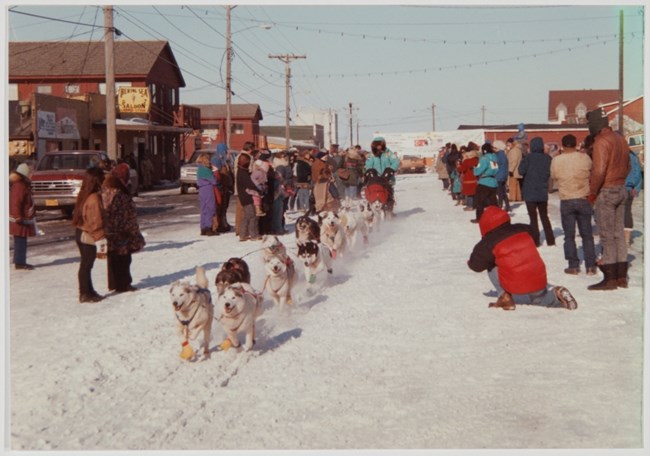Last updated: April 7, 2022
Article
The Hope Race

From 1946 to 1986, the Cold War between the United States and the Soviet Union prevented contact between people across the Bering Strait. As relations warmed in the 1980s and travel was allowed once again, ideas of collaborative events blossomed.
One of the events proposed was an international sled dog race, which would begin in Nome, Alaska and finish in Anadyr, Russia. With hard work from organizers on both sides of the Bering Strait, the race was approved and in 1991, eight mushers from four countries competed in the first ever Hope Race.

One of the challenges of the race was ensuring that all participants had their visas on time. At the start of the race, some mushers still did not have the documentation needed to enter Russia. Additionally, the soviet pilots who were to transport mushers from Wales to Uelen hadn't even applied for visas.
Without soviet pilots, the entire race was in jeopardy. It wasn't deemed safe for mushers to traverse the strait by dog sled, so without the pilots, the race would be off. Luckily, Immigration Officer Chick Trainor was sympathetic to the circumstance. "They can file their paperwork later. This is a race," he said.
Kate Persons, one of the mushers, remembers waiting in Wales, wondering if the helicopter pilots were going to be able to pick them up.
"We waited [in Wales] for about a week and none of us really knew if those helicopters were going to materialize or not. And it really was quite moving when they finally did come wafting out of the fog." -Kate Persons, Kotzebue

With the Bering Strait crossing finalized and visas in the hands of all mushers, the race was on. Ketil Reitan of Kaktovik, Peter Thomann of Willow, and Kate Persons of Kotzebue all vied for the lead. Despite getting lost for about 24 hours, it was Kate who crossed the finish line in Anadyr first, having traveled the race's 1,200 miles in 20 days, 15 hours, 25 minutes, and 20 seconds. She was greeted warmly with Chukchi dancers and a traditional Russian greeting of a large loaf of bread.
In reflecting on her experience, Kate said, "I expected the country to be beautiful, and it is, but what surprised me the most really was the people…. In the end really it was the people who captivated me more than anything."
The Hope Race was held again in 1992, but cooling relations, sponsorship difficulties, and confusion about customs made the international nature of the race complicated. Since 1992 the Hope/Надежда has been held as Chukotka only race.
The international Hope Race presented an opportunity for people in Beringia to remember and celebrate their shared heritage of dog sledding. They were able to see how the other side trained their dogs, the differences in breeds, the varying techniques in mushing, and to reconnect with their neighbors. It was a space for cultural exchange and cooperation. The race is still remembered fondly and many would welcome its return.
"...We'd love to do it again because it has such great benefits. It would promote the people, the area. What neater thing could you do than tie the history together as you take people into the future?" - Leo Rasmussen, Nome Mayor
The 1991 Hope Race Mushers
Kate Persons of Sikusuilaq Springs, Alaska
Frank Turner of Pelly Crossing, Yukon Territory Canada
Scott Cameron of Palmer, Alaska
Nicolai "Kola" Ettyne of Neshkan, USSR
Kazuo Kojima of Tokyo, Japan
Ketil Reitan of Norway who lived in Kaktovik, Alaska
Peter Thomann of Willow, Alaska, but originally from Switzerland
Mary Shields of Fairbanks, Alaska
You can learn more about the era of reconnection between the Soviet Union and the United States, which included collaborative events like the Hope Race, in an online exhibit Hope: Tales of the Friendship Flight Era.
Acknowledgements
Quotes are from interviews conducted by Sustain Steinacher in collaboration with the Shared Beringian Heritage Program.
Written by Meg Withers
